The Male Reproductive System
1/75
There's no tags or description
Looks like no tags are added yet.
Name | Mastery | Learn | Test | Matching | Spaced |
|---|
No study sessions yet.
76 Terms
What is the primary function of the male reproductive system?
To produce sperm and introduce them into the female body.
What is the copulatory organ in males?
The penis.
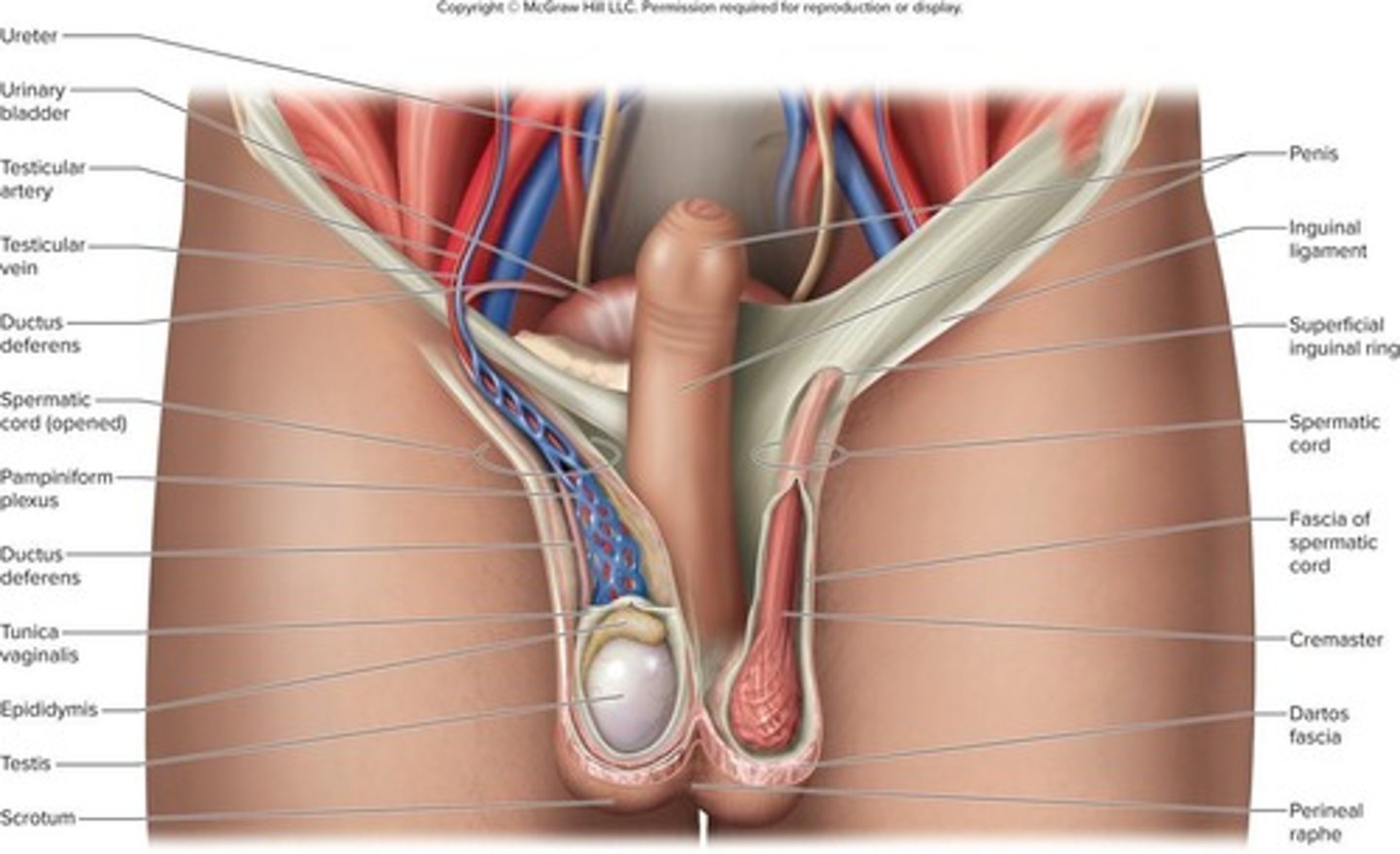
What are the primary sex organs in males and females?
Testes in males and ovaries in females.
- Produce sex cells
What are secondary sex organs in males?
A system of ducts and glands, including the penis that delivers sperm cells.
Where are the external genitalia located?
In the perineum.
What is the scrotum?
A pouch of skin, muscle, and fibrous connective tissue containing the testes.

Why does the left testicle usually descend lower than the right?
It is a common anatomical variation.
What is the function of the dartos fascia?
It is a layer of smooth muscle that contracts when cold, wrinkling the scrotum to reduce heat loss.
What temperature must the testes be held at for sperm production?
About 35°C.
What are androgen binding proteins?
Nurse cells that allow for the activation of testosterone
What is the role of the cremaster muscle?
It contracts to hold the testes closer to the body when cold and relaxes when warm.
What is the pampiniform plexus?
A venous plexus that surrounds the testicular artery and helps regulate temperature by removing heat from descending arterial blood.
What are the two classifications of reproductive organs?
External and internal genitalia.
Where are internal genitalia located?
In the pelvic cavity, except for the testes and some associated ducts in the scrotum.
What do the female reproductive system's functions include?
Producing eggs, receiving sperm, providing for gametes' union, harboring the fetus, and nourishing offspring.
What are the main components of male external genitalia?
The scrotum and penis.
What is the significance of the cooler environment of the scrotum?
It is necessary for the production of sperm.
What anatomical features border the perineum?
The pubic symphysis, ischial tuberosities, and coccyx.
What is the internal septum in the scrotum?
It divides the scrotum into right and left compartments.
What type of glands are the testes classified as?
Combined endocrine and exocrine glands.
What is the shape of each testis?
Oval and slightly flattened.
What is the function of sebaceous glands in the scrotum?
They contribute to the skin's lubrication and protection.
What is the role of sensory innervation in the scrotum?
It provides sensitivity to the area, contributing to sexual function.
What is the tunica albuginea?
A white, fibrous capsule that covers the testis.
How many lobules are formed by septa in the testis?
250 to 300 lobules.
What is produced in the seminiferous tubules?
Sperm.
What type of cells are found between seminiferous tubules and what do they produce?
Interstitial endocrine cells; they produce testosterone.
What lines each seminiferous tubule?
A thick germinal epithelium composed of several layers of germ cells and tall nurse cells.
What is the function of nurse cells in the seminiferous tubules?
They protect germ cells and promote their development.
What is the blood-testis barrier (BTB)?
A barrier formed by tight junctions between nurse cells that prevents antibodies and immune cells from attacking germ cells.
What is the rete testis?
A network that collects sperm from the seminiferous tubules.
Do sperm swim while in the male reproductive tract?
No, sperm do not swim while in the male reproductive tract.
What are the spermatic ducts?
A series of ducts that sperm travel through after leaving the testis to reach the urethra.
What are the efferent ductules?
About 12 small ciliated ducts that collect sperm from the rete testis and transport it to the epididymis.
What is the function of the epididymis?
It is the site of sperm maturation and storage.
What happens to sperm if they are not ejaculated?
They disintegrate and are reabsorbed by the epididymis.
What is the ductus deferens (vas deferens)?
A tube between the epididymis and the seminal vesicle.
What is the function of the ejaculatory duct?
It is formed where the ductus deferens and duct of the seminal vesicle merge, passing through the prostate and emptying into the urethra.
What are the three regions of the male urethra?
Prostatic, membranous, and spongy (penile) urethra.
What are the seminal vesicles?
A pair of glands that form 60% of semen, are posterior to the bladder, and empty into the ejaculatory duct.
What is the function of the prostate gland?
It surrounds the urethra and ejaculatory duct, forming 30% of semen and enhancing sperm motility.
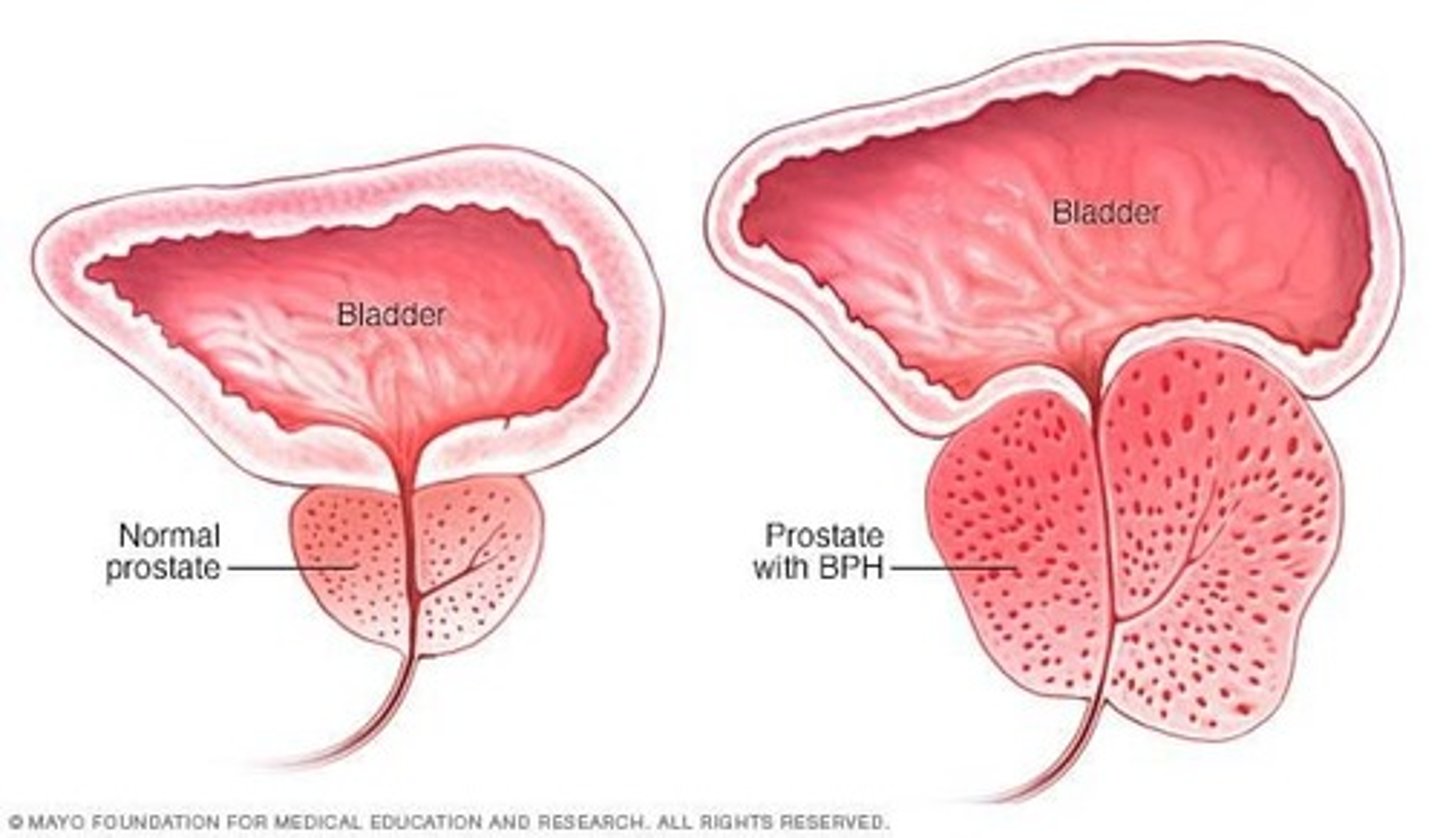
What do the bulbourethral glands produce?
A clear slippery fluid (pre-ejaculate) that lubricates the penis and protects sperm by neutralizing acidity in the urethra.
What is benign prostatic hyperplasia (BPH)?
A noncancerous enlargement of the prostate that compresses the urethra and obstructs urine flow.
What typically goes unnoticed until it becomes painful?
Prostate cancer.
How is prostate cancer commonly diagnosed?
Through a digital rectal exam (DRE) and elevated levels of serine protease (PSA) and acid phosphatase in the blood.
What is the primary function of the penis?
To deposit semen in the vagina.
What are the two main structural components of the penis?
An internal root and an externally visible shaft and glans.
What is the prepuce, and what is its significance?
The prepuce, or foreskin, is the skin that extends over the glans and is removed during circumcision.
What are the three cylindrical bodies of erectile tissue in the penis?
One corpus spongiosum and two corpora cavernosa.
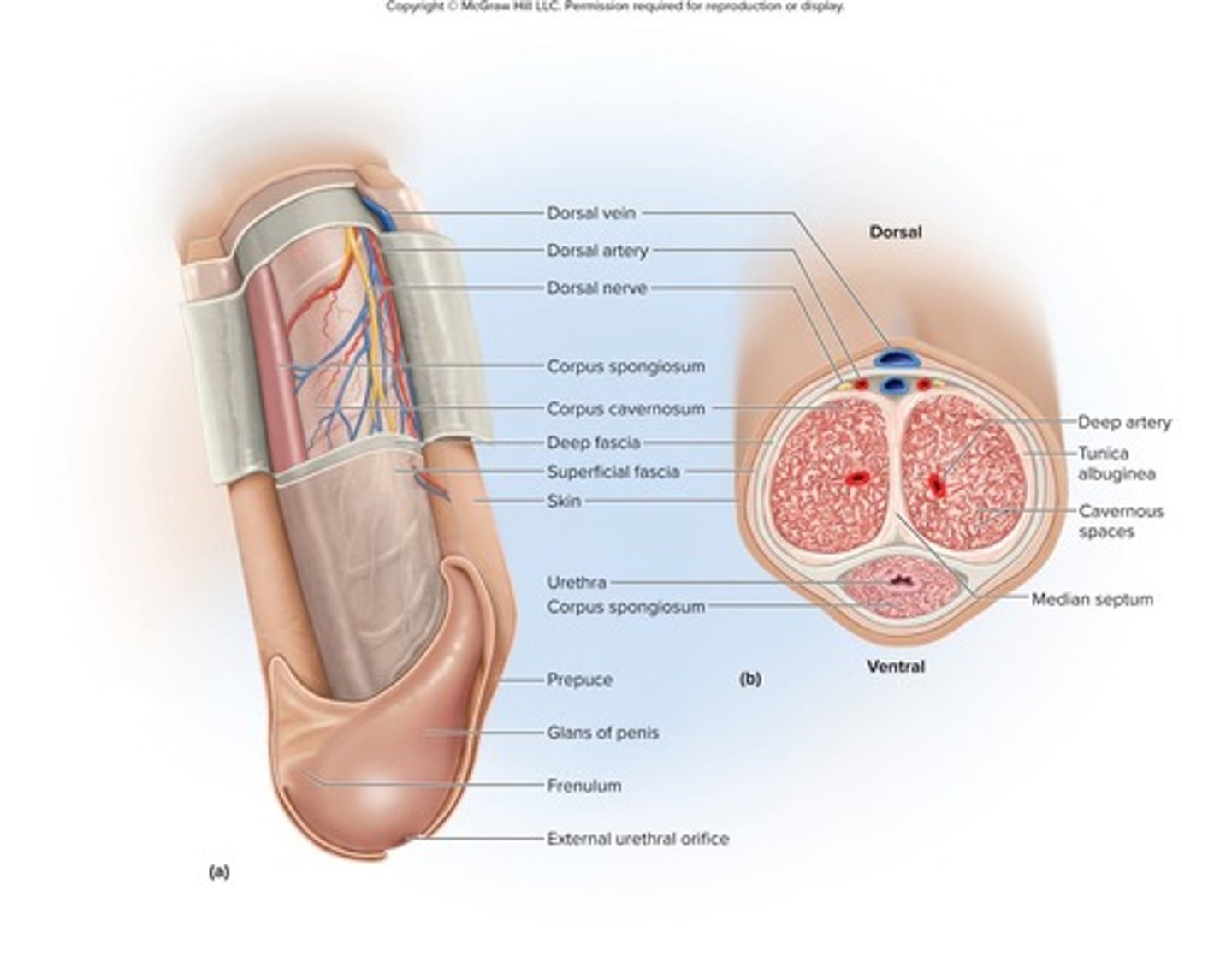
What is the function of the corpus spongiosum?
It encloses the spongy (penile) urethra and forms the glans penis.
How do the corpora cavernosa contribute to an erection?
They fill with blood during sexual arousal, causing an erection.
What is the role of the hypothalamo-pituitary-gonadal axis in male reproductive function?
It regulates reproductive function through hormone secretion.
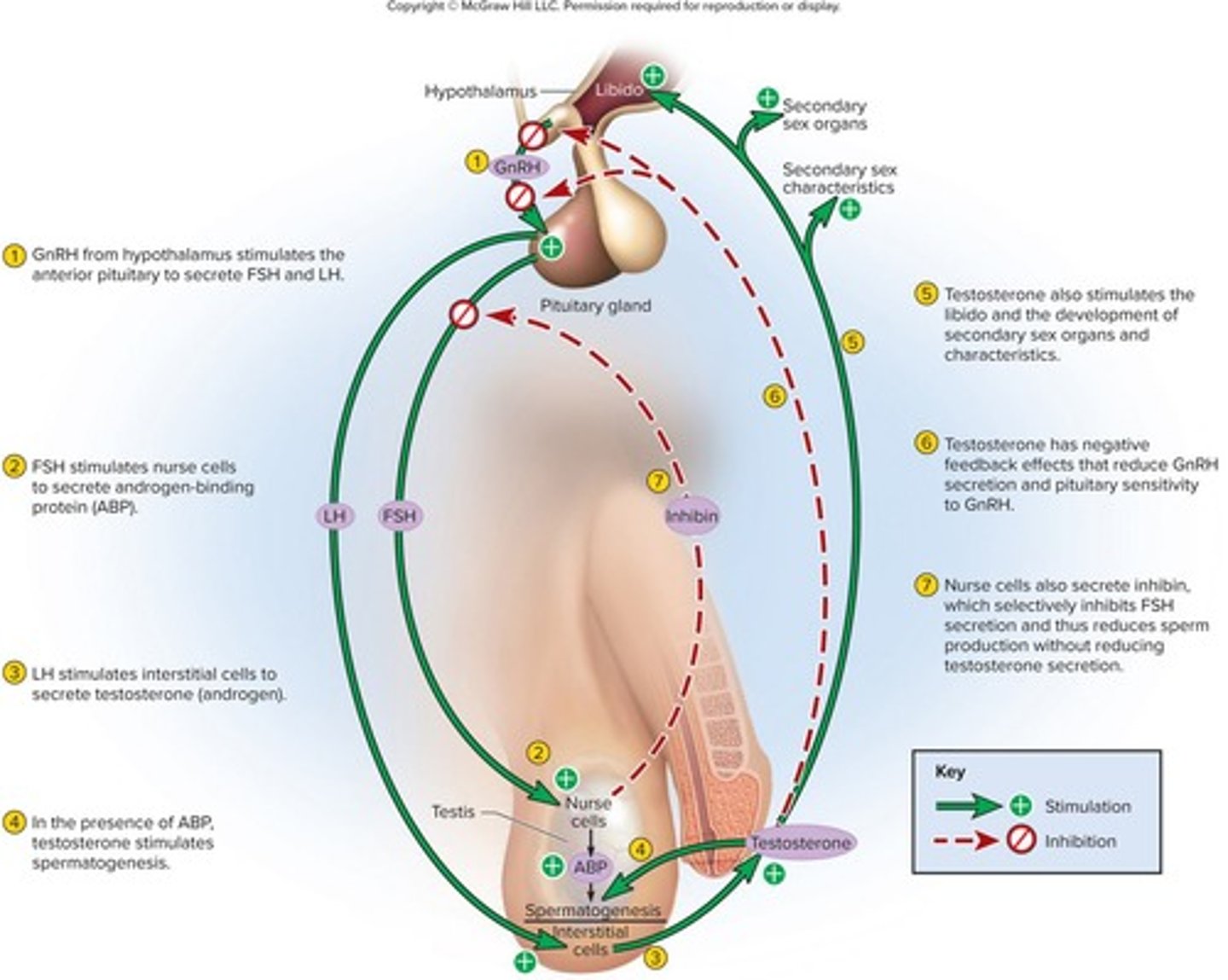
What hormone does the hypothalamus produce to stimulate the anterior pituitary?
Gonadotropin-releasing hormone (GnRH).
What are the two gonadotropins secreted by the anterior pituitary?
Follicle-stimulating hormone (FSH) and luteinizing hormone (LH).
What is the function of follicle-stimulating hormone (FSH) in male reproduction?
It stimulates nurse cells to secrete androgen-binding protein (ABP) that binds testosterone and stimulates spermatogenesis.
What do nurse cells secrete to suppress FSH secretion?
Inhibin.
What is the significance of androgen-binding protein (ABP)?
It binds testosterone and is essential for stimulating spermatogenesis.
What anatomical feature allows the skin over the penis shaft to expand?
The skin is loosely attached.
What are cavernous spaces (lacunae) in the erectile tissues?
They are blood sinuses that fill with blood during an erection.
What happens to the penis during sexual arousal?
The erectile tissues fill with blood, causing an erection.
What is luteinizing hormone (LH) also known as?
Interstitial cell-stimulating hormone (ICSH)
What does luteinizing hormone (LH) stimulate in the male reproductive system?
It stimulates interstitial endocrine cells to produce androgens, primarily testosterone.
What is spermatogenesis?
The process of sperm production in seminiferous tubules.
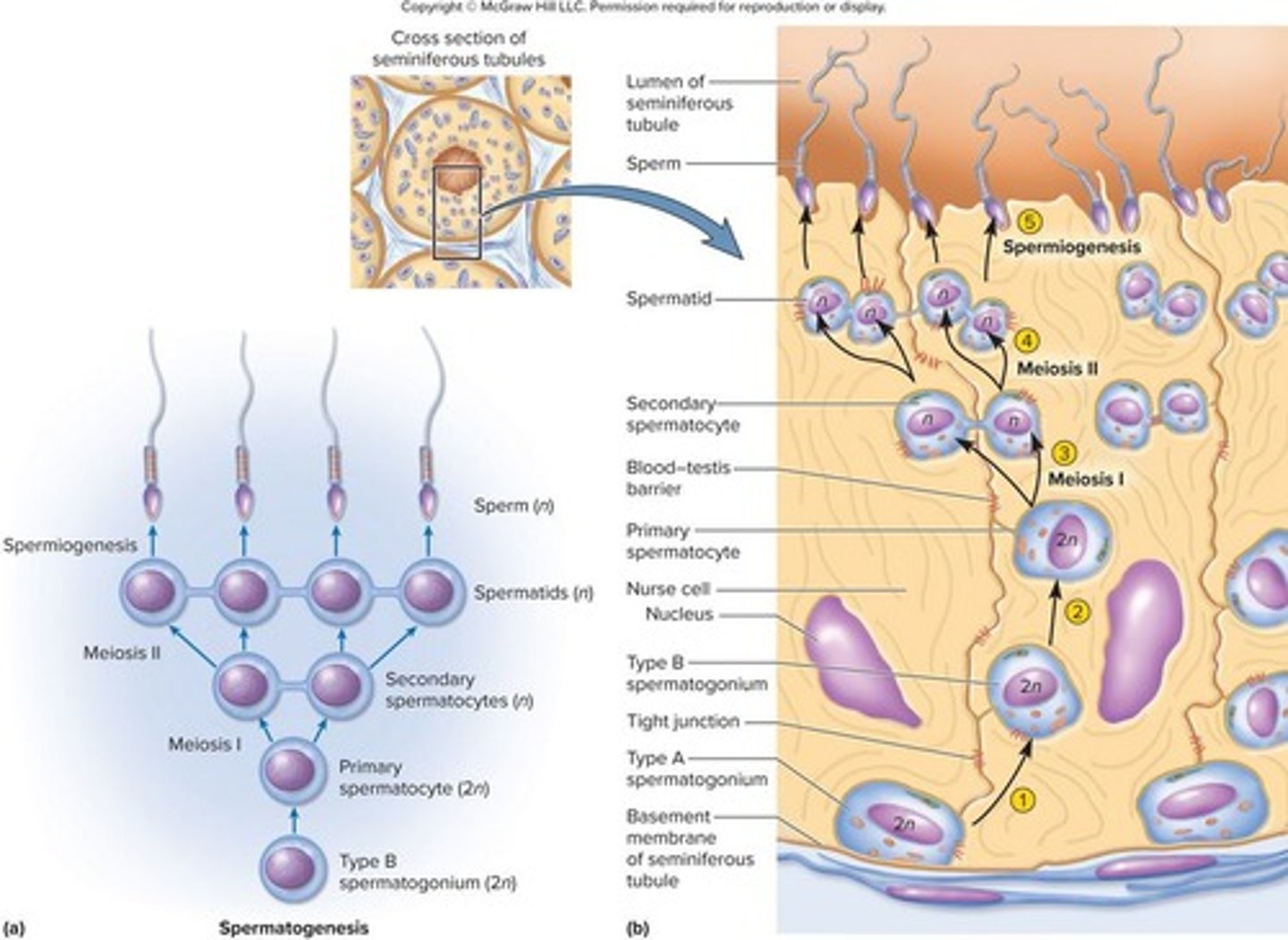
What are the three principal events involved in spermatogenesis?
1. Division and remodeling of large germ cells into small, mobile sperm cells with flagella. 2. Reduction of chromosome number by one-half. 3. Shuffling of genes to ensure genetic variation in offspring.
What type of cell division occurs during spermatogenesis?
Meiosis.
What is the structure of a spermatozoon?
A spermatozoon has two parts: a head and a tail.
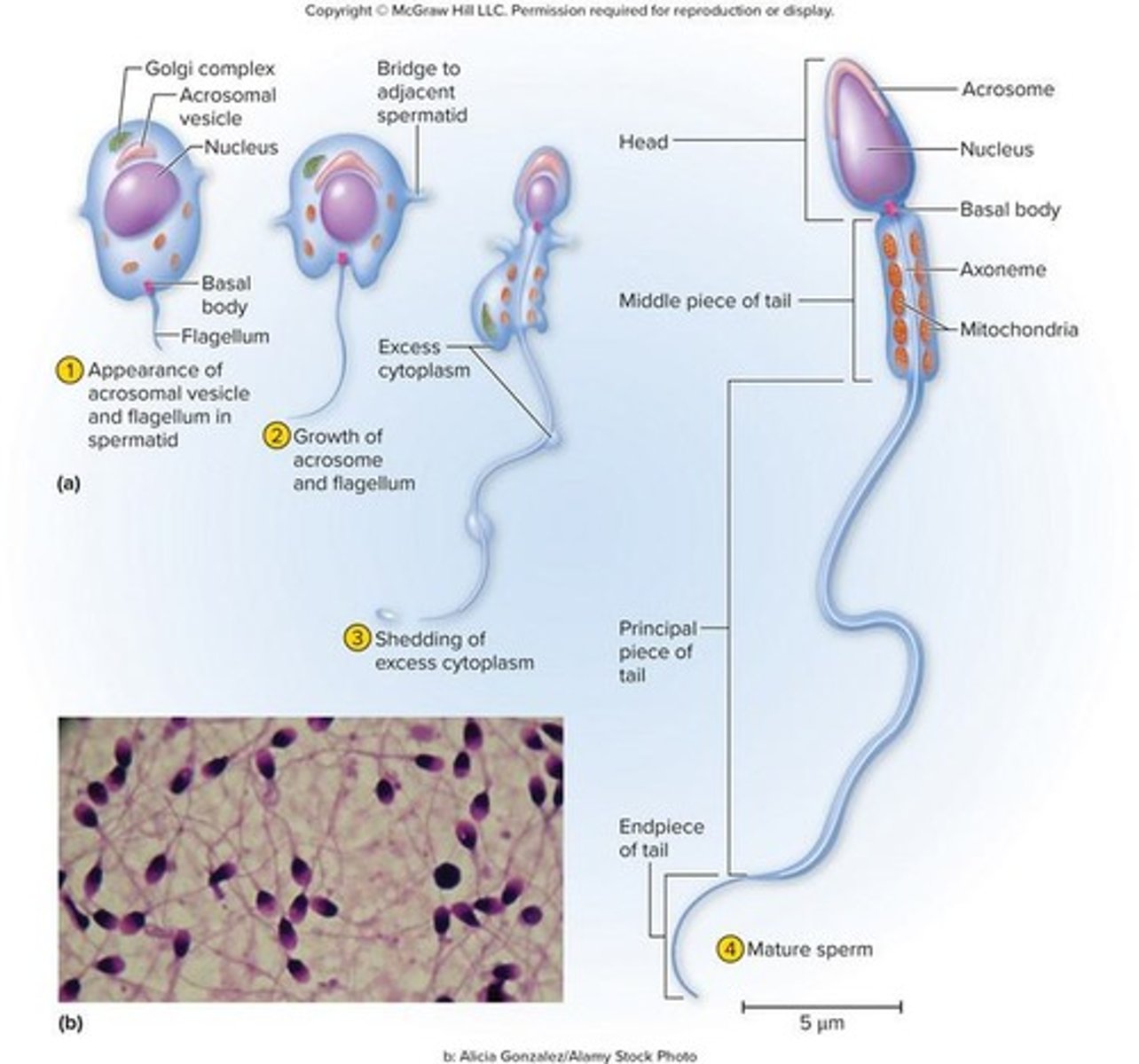
What does the head of a spermatozoon contain?
A pear-shaped nucleus with a haploid set of chromosomes and an acrosome that contains enzymes to penetrate the egg.
What are the three regions of the tail of a spermatozoon?
1. Middle piece - contains mitochondria for ATP production. 2. Principal piece - axoneme surrounded by supporting fibers. 3. Endpiece - very narrow tip of the flagella.
What is semen?
Semen (seminal fluid) is the fluid expelled during ejaculation.
What is the primary component of semen?
Seminal plasma, a mixture of glandular secretions from seminal vesicles, prostate, and bulbourethral glands.
What is considered a normal sperm count?
50 to 120 million sperm per mL.
What sperm count is classified as infertility?
Less than 20 million sperm per mL.
What are the two requirements for sperm motility?
Elevated pH and an energy source.
How does prostatic fluid contribute to sperm function?
It buffers vaginal acidity from pH 3.5 to 7.5 and provides zinc to stabilize chromatin in the sperm head.
What do seminal vesicles provide to sperm?
Fructose and citrate for ATP production, and calcium for flagellar function.
What role do prostaglandins from seminal vesicles play?
They may thin the mucus of the cervical canal and stimulate contractions in the uterus and uterine tubes to spread the semen.